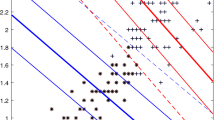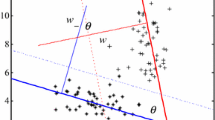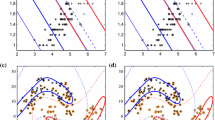Abstract
In the paper, to improve the performance of discriminative information-based nonparallel support vector machine (DINPSVM), we propose a novel algorithm called reductive and effective discriminative information-based nonparallel support vector machine (REDINPSVM). First, we introduce the regularization term to achieve the structural risk minimization principle. This embodies the marrow of statistical learning theory, so this modification can enhance the generalization ability of classification algorithms. Second, we apply the k-nearest neighbor method to eliminate some redundant constraints that would cut down on time complexity. Finally, to accelerate the computation, we introduce the least squares technique to solve two systems of linear equations. Comprehensive experimental results on twenty-three UCI benchmark datasets and six Image datasets demonstrate the validity of the proposed method.



Similar content being viewed by others
Notes
The prior data distribution information refers to the information obtained from the characteristic spatial distribution of known data.
The prior discriminant information refers to the information obtained by bringing the known samples into the discriminant function.
The space here refers to the feature space, and the prior spatial distribution information represents the information obtained from the characteristic spatial distribution of known data.
References
Bhavan A, Chauhan P, Hitkul SRR (2019) Bagged support vector machines for emotion recognition from speech. Knowl-Based Syst 184:104886
Chang C C, Lin C J (2011) Libsvm: a library for support vector machines. ACM Trans Intell Syst Technol 2(3):1–27
Chen G, Fu K, Qiang W, Tu E, Jie Y (2014) Semi-supervised classification with pairwise constraints. Neurocomputing 139:130–137
Demiar J, Schuurmans D (2006) Statistical comparisons of classifiers over multiple data sets. J Mach Learn Res 7(1):1–30
Gomez-Verdejo V, Martinez-Ramon M, Arenas-Garcia J, Lazaro-Gredilla M, Molina-Bulla H (2011) Support vector machines with constraints for sparsity in the primal parameters. IEEE Trans Neural Netw 22(8):1269–1283
Hong Z, Yiu C (2012) Semi-supervised maximum margin clustering with pairwise constraints. IEEE Trans Knowl Data Eng 24(5):926–939
Huang H, Wei X, Zhou Y (2018) Twin support vector machines: a survey. Neurocomputing 300(26):34–43
Hui W, Xi L (2009) Application of fuzzy neural network to the flood season precipitation forecast. Knowl-Based Syst 83:58–65
Hui X, Chen S, Qiang Y (2008) Structural support vector machine. Int Symp Neural Netw 5263:501–511
Jayadeva KR, Chandra S (2007) Twin support vector machines for pattern classification. IEEE Trans Pattern Anal Mach Intell 29(5):905–910
Khemchandani R, Sharma S (2016) Robust least squares twin support vector machine for human activity recognition. Appl Soft Comput:33–46
Kumar M A, Gopal M (2009) Least squares twin support vector machines for pattern classification. Expert Syst Appl 36(4):7535–7543
Lomakina B E I (2011) Support vector machine regression (svr/ls-svm)–an alternative to neural networks (ann) for analytical chemistry comparison of nonlinear methods on near infrared (nir) spectroscopy data. Analyst 136(8):1703–1712
Lu S, Wang H, Zhou Z (2019) All-in-one multicategory ramp loss maximum margin of twin spheres support vector machine. Appl Intell 49(6):2301–2314
Maggini M, Melacci S, Sarti L (2012) Learning from pairwise constraints by similarity neural networks. Neural Netw 26:141–158
Mir A, Nasiri J A (2018) Knn-based least squares twin support vector machine for pattern classification. Appl Intell 48(12):4551–4564
Miyamoto S, Terami A (2010) Semi-supervised agglomerative hierarchical clustering algorithms with pairwise constraints. IEEE Int Conf Fuzzy Syst:1–6
Nishijima M, Nieuwenhoff N, Pires R, Oliveira P R (2020) Movie films consumption in brazil: an analysis of support vector machine classification. AI and Soc 35(2):451–457
Pan X, Luo Y, Xu Y (2015) K-nearest neighbor based structural twin support vector machine. Knowl-Based Syst 88:34–44
Qha B, Jz B, Ll C, Yw A, Ling J B (2019) Discriminative information-based nonparallel support vector machine. Signal Process 162:169–179
Qi Z, Tian Y, Yong S (2013) Structural twin support vector machine for classification. Knowl-Based Syst 43(2):74–81
Shao Y H, Zhang C H, Wang X B, Deng N Y (2011) Improvements on twin support vector machines. IEEE Trans Neural Netw 22(6):962–968
Shao Y H, Wang Z, Chen W J, Deng N Y (2013) Least squares twin parametric-margin support vector machine for classification. Appl Intell 39(3):451–464
Sharma S, Rastogi R, Chandra S (2021) Large-scale twin parametric support vector machine using pinball loss function. IEEE Trans Syst Man Cybern Syst 51(2):987–1003
Tanveer M, Sharma A, Suganthan PN (2019a) General twin support vector machine with pinball loss function. Inf Sci 494:311–327
Tanveer M, Tiwari A, Chou D, Hary R, Jalan S (2019b) Sparse pinball twin support vector machines. Appl Soft Comput 78:164–175
Tian Y, Qi Z, Ju X, Shi Y, Liu X (2014) Nonparallel support vector machines for pattern classification. IEEE Trans Cybern 44(7):1067–1079
Vapnik VN (1995) The Nature of Statistical Learning Theory. Springer
Wang H, Zhou Z, Xu Y (2017) An improved ν-twin bounded support vector machine. Appl Intell 48(3):1–13
Xie F, Xu Y (2019) An efficient regularized k-nearest neighbor structural twin support vector machine. Appl Intell 49(12):4258–4275
Xu Y, Pan X, Zhou Z, Yang Z, Zhang Y (2015) Structural least square twin support vector machine for classification. Appl Intell 42(3):527–536
Ye Q, Zhao C, Gao S, Hao Z (2012) Weighted twin support vector machines with local information and its application. Neural Netw 35:31–39
Yu D, Xu Z, Wang X (2020) Bibliometric analysis of support vector machines research trend: a case study in china. Int J Mach Learn Cybern 11(3):715–728
Yu J, Tao D, Yong R, Cheng J (2013) Pairwise constraints based multiview features fusion for scene classification. Pattern Recogn 46(2):483–496
Zhao J, Min C, Zhao Z, Luo Q (2010) Localized pairwise constraint proximal support vector machine. IEEE Int Conf Cogn Inf:908–913
Zhao Z, Ning Y (2009) Constraint projections for discriminative support vector machines. Int Joint Conf Bioinform:501–507
Zhu Y, Wang Z, Gao D (2015) Matrixized learning machine with modified pairwise constraints. Pattern Recogn 48(11):3797–3809
Acknowledgements
We gratefully thank the anonymous reviewers for their helpful comments and suggestions. This work was supported in part by the National Natural Science Foundation of China (No. 12071475) and the Fundamental Research Funds for the Central Universities (No. BLX201928).
Author information
Authors and Affiliations
Corresponding author
Additional information
Publisher’s note
Springer Nature remains neutral with regard to jurisdictional claims in published maps and institutional affiliations.
Rights and permissions
About this article
Cite this article
Wang, C., Wang, H. & Zhou, Z. Reductive and effective discriminative information-based nonparallel support vector machine. Appl Intell 52, 8259–8278 (2022). https://doi.org/10.1007/s10489-021-02874-6
Accepted:
Published:
Issue Date:
DOI: https://doi.org/10.1007/s10489-021-02874-6




